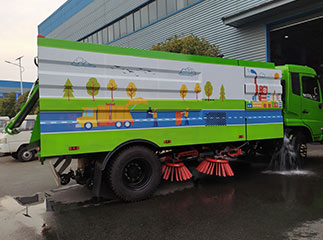Volvo Garbage Truck: A Comprehensive Guide to Efficiency and Sustainability

Introduction
In the realm of waste management, efficiency and sustainability are paramount. The Volvo garbage truck stands out as a leading choice for municipalities and waste management companies across the globe. Known for their reliability, safety features, and low emissions, Volvo garbage trucks are not just vehicles; they represent a commitment to managing waste responsibly. This article will explore the various aspects of Volvo garbage trucks, their features, benefits, and the impact they make on urban environments.
1. History of Volvo’s Commitment to Waste Management
Volvo Group began in 1927 with a focus on robust vehicle production. Over the decades, Volvo has expanded its offerings, prioritizing sustainability alongside performance. The introduction of specialized vehicles, such as garbage trucks, reflects an evolution in understanding urban waste management needs.

1.1 Evolution of Volvo Trucks
From the initial designs aimed at local deliveries to the sophisticated models today, Volvo trucks have incorporated advanced technologies to improve efficiency and reduce environmental impact. This evolution sets the stage for their garbage truck models.
2. Key Features of Volvo Garbage Trucks
Volvo garbage trucks are engineered with precision to fulfill the diverse needs of waste collection. Here are some standout features:
2.1 Advanced Safety Mechanisms
- Automatic Brake Systems
- Blind Spot Detection
- High Visibility Cab Design
2.2 Fuel Efficiency and Low Emissions
Equipped with efficient engines, Volvo garbage trucks comply with stringent emission standards, significantly lowering their ecological footprint during operations.
2.3 Ergonomic Driver Interfaces
Volvo emphasizes driver comfort with ergonomic cabins, intuitive controls, and ample space, reducing fatigue and enhancing safety during long shifts.
2.3.1 User-Friendly Dashboard
The dashboard is designed for easy access to essential controls, making it straightforward for drivers to navigate while focusing on waste collection tasks.
3. Different Models of Volvo Garbage Trucks
Volvo offers several models tailored to various waste management tasks:
3.1 Volvo FE Series
This series is known for its versatility and compact size, ideal for urban environments.
3.2 Volvo FM Series
The FM series provides a higher payload capacity, perfect for larger waste collection operations.
3.3 Volvo FMX Series
Designed for rough terrains, the FMX series is suited for construction and demolition waste, offering greater durability and reliability.
4. The Role of Technology in Volvo Garbage Trucks
Technology integration is another hallmark of Volvo garbage trucks, enhancing their functionality and efficiency.
4.1 Telematics and Fleet Management
Volvo’s telematics system allows fleet managers to gather real-time data, optimizing routes and improving service delivery.
4.2 Automation and Smart Systems
With advancements in automation, several Volvo garbage truck models now feature automated loading systems, reducing the physical strain on operators.
4.2.1 How Automation Benefits Waste Management
- Increased Operational Efficiency
- Lower Labor Costs
- Improved Safety for Workers
5. Environmental Benefits of Volvo Garbage Trucks
Volvo is committed to sustainable practices, and its garbage trucks are no exception. They deliver multiple environmental benefits:
5.1 Reduced Carbon Footprint
Due to advanced fuel technology, Volvo garbage trucks emit fewer greenhouse gases compared to older models.
5.2 Noise Pollution Reduction
Design innovations have led to quieter trucks, minimizing noise pollution during early morning collections in residential areas.
6. Real-World Case Studies on Volvo Garbage Trucks
Several municipalities have successfully integrated Volvo garbage trucks into their fleets, leading to notable improvements.
6.1 Case Study: City of Amsterdam
Amsterdam adopted Volvo electric garbage trucks, resulting in a 40% reduction in emissions in central districts. The quiet operation has also improved neighborhood quality.
6.2 Case Study: San Francisco Waste Management
San Francisco’s fleet of Volvo FMX trucks operates in rugged terrain, enhancing efficiency in refuse collection while navigating narrow streets.
7. Maintenance Tips for Volvo Garbage Trucks
To keep Volvo garbage trucks in optimal condition, adherence to maintenance schedules is essential.
7.1 Regular Inspections

Conduct routine inspections to identify wear and tear on crucial components.
7.2 Utilize Genuine Volvo Parts
Using genuine parts ensures longevity and maintains the performance of your Volvo garbage truck.
7.2.1 Maintenance Checklist
| Maintenance Task | Frequency |
|---|---|
| Oil Change | Every 5,000 miles |
| Brake Inspection | Every 3 months |
| Tire Rotation | Every 6 months |
8. The Cost of Volvo Garbage Trucks
Investing in a Volvo garbage truck comes with significant cost considerations, including purchase price, maintenance costs, and operational expenses.
8.1 Purchase Price Ranges
The cost of a new Volvo garbage truck can range from $250,000 to over $500,000, depending on the model and specifications.
8.2 Total Cost of Ownership
When factoring in maintenance, fuel, and operational costs, the total cost of ownership can be substantial. However, the efficiency and reliability often justify the investment.
9. Fuel Options and Their Impact
Volvo offers various fuel options ranging from diesel to environmentally friendly alternatives such as compressed natural gas (CNG) and electric models.
9.1 Diesel vs. Alternative Fuels
While diesel models offer reliability and efficiency, CNG and electric options further reduce emissions and fuel costs in the long run.

9.1.1 Comparison Table
| Fuel Type | Advantages | Disadvantages |
|---|---|---|
| Diesel | High Torque, Widely Available | Higher Emissions |
| CNG | Lower Emissions, Cheaper Fuel | Limited Refueling Stations |
| Electric | Zero Emissions, Low Operating Costs | High Initial Cost, Range Limitations |
10. Future of Volvo Garbage Trucks
As urbanization increases and waste management becomes more critical, Volvo is poised to lead the charge with innovative solutions. The future will likely see greater integration of electric vehicles in waste fleets, improved automation, and expanded telematics capabilities for enhanced fleet management.
FAQs
1. What makes Volvo garbage trucks environmentally friendly?
Volvo garbage trucks are designed to minimize emissions through advanced engine technology, promote fuel efficiency, and incorporate electric models to reduce their carbon footprint.
2. How often should Volvo garbage trucks be serviced?
Regular maintenance is essential, with oil changes recommended every 5,000 miles and complete inspections every three months.
3. Are electric Volvo garbage trucks suitable for all urban areas?
While electric garbage trucks are ideal for many urban environments, they may face limitations in terms of range and charging infrastructure, making them more suitable for certain cities.
4. What are the main advantages of using automated loading systems?
Automated loading systems improve operational efficiency, enhance safety for drivers, and reduce physical strain during waste collection.
5. How does the Volvo FE series differ from the FM series?
The Volvo FE series is more compact and suited for urban waste collection, while the FM series offers higher payload capacities for larger waste management operations.
6. What is the expected lifespan of a Volvo garbage truck?
With proper maintenance, a Volvo garbage truck can have a lifespan ranging from 10 to 15 years, depending on usage and operating conditions.
